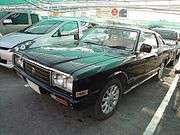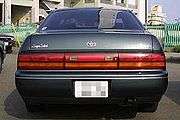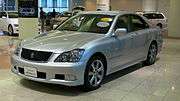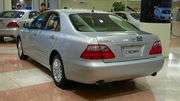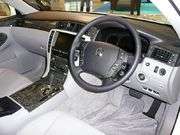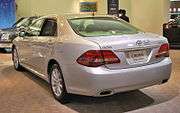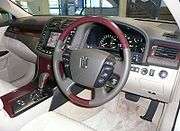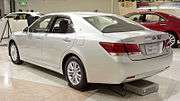Toyota Crown
| Toyota Crown | |
|---|---|
 | |
| Overview | |
| Manufacturer | Toyota |
| Production | 1955–present |
| Assembly | |
| Body and chassis | |
| Class | Mid-size luxury car |
| Body style |
|
| Platform | S-series |
| Related | |
| Chronology | |
| Successor |
|
The Toyota Crown (Japanese: トヨタクラウン Toyota Kuraun) is a line of mid-size luxury sedans by Toyota primarily aimed at the Japanese market and sold in other select Asian markets.
Introduced in 1955, it has served as the mainstream sedan from Toyota in the Japanese market throughout its existence and holds the distinction of being the longest running passenger-car nameplate affixed to any Toyota model, along with being the first Toyota vehicle to be exported to the United States in 1958. Its traditional competitors in Japan and Asia have been the Nissan Cedric/Gloria/Fuga and the Honda Legend, along with the defunct Mazda Luce, Isuzu Bellel, and Mitsubishi Debonair.
Available at Toyota Store dealers in Japan, the Crown has been popular for government usage, whether as a police car or for transporting government officials. It has also been popular with Japanese companies as company cars along with use as a taxicab. While a base Crown was available for many years aimed at the taxicab market, the increasing opulence and price of the Crown line led to the creation of the Toyota Comfort in 1995 as a more affordable alternative.
In North America, the first through fourth generations were offered from 1958 through 1973.[2] It was replaced with the Toyota Corona Mark II, which was later renamed the Toyota Cressida, after which the Cressida was replaced by the Toyota Avalon as Toyota's large sedan in North America. The Crown has also been partially succeeded in export markets by its closely related sibling, the Lexus GS, which since its debut in 1991 as the Toyota Aristo has always shared the Crown's platform and powertrain options. Later models of the GS and Crown have taken on a very strong aesthetic kinship through shared design cues.
The Crown's history and reputation has given it prominence in the Toyota lineup, as it is one of the few current Toyota models to carry its own unique insignia for the model line with the current Crown having a stylized crown emblem on the grille and steering wheel along with inspiring the names of its smaller progenitors. The Corona, introduced as a smaller companion to the Crown means "crown" in Latin and was initially exported as the "Tiara", while the Corolla took its name from the regal chaplet. The Camry's name is derived from the Japanese phrase kanmuri (冠, かんむり) meaning "little crown" and the Toyota Scepter took its name from the sceptre, an accessory to a crown.
Export

The Crown was exported to the United States from 1958 to 1973.[2] Exports to Europe began in 1964 with the first cars going to Finland. Other European countries which saw early imports of the Crown included the Netherlands and Belgium. Canada sold the Crown from 1965 to 1973. The United Kingdom was another market until the early 1980s. It was also exported to Canada for a few years—1965–68. Australia was another important export market for the Crown—to the extent that it was manufactured there from the mid-1960s until the late 1980s using many local components. Trinidad and Tobago was also another country where the Toyota market had a successful run, which saw some productions between 1960 and 1980. The current island nations of Aruba and Curaçao in the Southern Caribbean also imported the Toyota Crown starting from the 2nd generation (S40) in 1965 in Curaçao up until importation of the 10th generation (S150) was discontinued in 1998 due to the high price and low demand combined with the introduction of the Lexus GS series.
First (RS Model-S30 Model: 1955 to 1962)
| First generation (RS series) | |
|---|---|
 | |
| Overview | |
| Production | 1955–1962 |
| Body and chassis | |
| Class | Mid-size luxury car |
| Body style |
|
| Related | |
| Powertrain | |
| Engine | |
| Dimensions | |
| Wheelbase | 2,530 mm (99.6 in) |
| Length | 4,285 mm (168.7 in) |
| Width | 1,679 mm (66.1 in) |
| Height | 1,524 mm (60.0 in) |
| Curb weight | 1,152 kg (2,540 lb) |
The Crown were introduced in 1955 in Japan to meet the demands of public transportation.[3] The Crown was intended for private purchase, while the Master served in a commercial form as a taxi, both with the same 1.5 L Type R engine used on their previous car, the Toyopet Super. The front doors open conventionally, and the rear doors are "suicide doors", a feature also utilized on the Toyota AA, Toyota's first car. Small engine displacements were used to keep the vehicle affordable, as the Japanese Government began to impose an annual road tax to help develop and maintain a national transportation infrastructure in 1950. The appearance of the Crown shows some similarities with the European Ford Versailles and Simca Vedette.
The Crown was much more popular than the Master due to the more compliant suspension of the Crown, and while the Master was intended for taxi service, the Crown was more accepted by the market over the Master, and more Crowns were sold into taxi service than the Master. The Crown was designed to replace the Super but Toyota was not sure if its independent front coil suspension and its suicide type rear doors were too radical for the taxi market to bear. So the Super was updated, renamed the Master and sold in tandem to the Crown, at Toyota Store locations. When sales of the Crown proved worthwhile, the Master was discontinued in November 1956 after being in production for only one year, and production facilities for the Master were transferred to the Crown.[4] While the Master was discontinued the commercial vehicle based thereon, the Masterline, continued to be offered (utilities, wagons and vans) until 1959. A six-door wagon known as the Airport Limousine was shown as a concept car at the 1961 Tokyo Motor Show. It did not go into production.
In December 1955 the Crown Deluxe (RSD) was introduced, a posher model equipped with a radio and heater as standard.[5] The initial RS model received a cosmetic update in 1958 to become the RS20, now with hooded headlights and a single-piece front windshield. In October 1959 Japan's first diesel-engined passenger car, the Crown Diesel, was introduced. Its C-series engine only had 40 PS (29 kW).[6] In October 1960 the 1.5 L R engine was complemented by the larger 1.9 L (1,896 cc) 3R engine for a model called the RS30, originally only available in the Deluxe version. The 1900 was also available with the new two-speed Toyoglide automatic transmission.[7] In April 1961 a Crown Standard 1900 was added.
Its coil and double wishbone independent front suspension[8] was a departure from the leaf sprung live axle front suspension used on most previous models but was similar to the independent front suspension used on the 1947 Toyopet SA. The live axle rear suspension was similar to that used on most of the previous models (unlike the trailing arm rear suspension used on the SA). Taxi versions were produced and beginning in March 1959 commercial versions of the vehicle were also available, as an estate wagon and a three- or six-seater coupe utility.[9] These took over the "Toyopet Masterline" name in the Japanese domestic market, but usually received "Crown" badges in the export. The "Crown" name was previously in use by the Imperial limousine manufactured by Chrysler in the early 1950s.
In 1958 it introduced a Ball joint suspension.[8] Production of the Masterline pickup started in April 1957 by the former Central Motors.[10]
In August 1957, three Toyota delegates with the intent to establish a sales company in the United States introduced a white and black Crown and Crown Deluxe at a public relations event attended by dealers and the media.[11] Both models were constructed with 50% thicker steel than the average American car at the time and the black Deluxe model was nicely appointed with lots of chrome and luxurious items like a radio, heater and whitewall tires which prompted the press to liken it to a "baby Cadillac".[12] This promising initial showing along with the strong reputation of the Crown in Japan gave Toyota the confidence to pursue exports to the United States despite known high-speed performance issues.[11] As a publicity stunt to demonstrate the car's reliability, Toyota staged a campaign common to American automakers: a coast-to-coast endurance run from Los Angeles to New York. The Toyopet was barely able to limp into Las Vegas before the project had to be called off .
Toyota's first export to the United States began with 30 Crown Deluxe's in June 1958 after establishing Toyota Motor Sales USA the previous October, the first directly managed retail dealer (Hollywood Toyota) the previous February, U.S. wholesale and import companies, and a parts warehouse in Long Beach.[11][13] Toyota also signs up 45 dealers to sell cars in its initial year, growing to 70 dealers by 1960 and 90 by 1962.[13] In the effort to obtain certification from the California Highway Patrol for the sale of the Crown in California, Toyota shipped the cars without headlights and installed General Electric sourced sealed beam units upon arrival which met the required standard for brightness.[11]
Since the car was designed for the muddy, slow, unpaved Japanese roads, it failed the mass urban landscape of the US because of its inability to keep up with traffic on the faster interstate highways, along with stability, noise and vibration concerns.[11][14] The car was also very rigid and heavy for its size at 2700 pounds. Motor Trend reported "The Toyopet is so rigid that jacking up one wheel at the rear bumper quickly lifted the other rear wheel". They also observed an average of 23.5 mpg combined city/highway for 407 miles.[15] To remedy the performance issues along with the resulting breakage of parts from being overly stressed, Toyota introduced the newer RS22L and the RS32L series Crown with the larger 3R engine and other improvements for high-speed driving in July 1960.[11]
For 1958, Toyota introduced the Crown in sedan form only (Standard and Deluxe) with a base price of $2187. Options included $94 AM radio and $75 whitewall tires. By comparison, an optioned up Crown was $32 more than the base Chevy Del Ray and $10 more than the Rambler Rebel V8 sedan.[15] Total sales for the initial year were 287.[13] For 1959 sales were again limited to only sedan models and despite a price boost to $2329 for the Deluxe model, sales more than tripled to 967 units.[13][15] For 1960, Toyota added a wagon body style ($2111 for the two-door, $2211 for the four-door) but in the midst of Detroit's Big Three compact cars (Ford Falcon, Chevy Corvair and Plymouth Valiant), sales fell to 659 units. For 1961 the Crown was being sold with the newer 3R engine and alongside the new smaller Tiara model with the Crown's outgoing 1.5L engine. Only the Custom sedan and wagon were offered ($1795 and $2080 respectively). Total sales for 1961 reached only 225 units, trailing off to 74 for 1962, and finally 28 for 1963.[13][15] Total sales for the Toyopet Crown RS series in the United States is 2,240.[15]
By the end of 1960, Toyota Motor Sales USA had accumulated 1.42 million dollars in losses from lackluster sales of the Crown. To prevent any further loss, all passenger car imports were suspended and new management structures were established to refocus all sales efforts on the Toyota Land Cruiser with profitability expected from selling 50 to 60 per month until the development of a new car suitable for the US market.[16]
In November 2000, Toyota released the Origin, a retro version of the RS series Crown to celebrate 100 million vehicles having been built in Japan.
|
Second (S40 Model: 1962 to 1967)
| Second Generation | |
|---|---|
_sedan_(15696855227).jpg) Toyota Crown MS40 Sedan | |
| Overview | |
| Production |
1962–1967 February 1967–unknown (Australia)[17] |
| Assembly | |
| Body and chassis | |
| Body style |
|
| Powertrain | |
| Engine | |
| Transmission |
|
| Dimensions | |
| Wheelbase | 2,690 mm (105.9 in) |
| Length |
|
| Width |
|
| Height | 1,460 mm (57.5 in) |
| Curb weight |
|
Due to the introduction of the Corona, the dramatically restyled and enlarged Series S40 was launched in 1962, and saw the introduction of the Custom model. According to the Japanese Wikipedia article for the Crown, the styling was said to be influenced by the recently introduced Ford Falcon in 1960. The front grille approach has a similar appearance to the 1960 Imperial Crown (Chrysler), which speaks to Toyota's aspirations that the Crown be a large, comfortable sedan. The station wagon body style carried over from the previous generation Masterline, but with more attention to the luxurious approach used on the Crown.
Headlights were integrated within the boundaries of the greatly enlarged grille, providing a clean, modern appearance. A 2-speed automatic transmission was introduced, called Toyoglide, with a column shift. A bigger and better car than the previous S30 series, it initially had four-cylinder R-series engines before the addition of the "M" six-cylinder engine in 1965. Deluxe and Super Deluxe models were available with added features. The sedan and wagon were known simply as the Crown while the commercial vehicles (coupe utility, double cab coupe utility (pick ups), and van) were known as the Masterline. There was also a limited run of the sedan known as the Toyota Crown S (MS41S) which featured a twin carburettor intake manifold on the 2.0L M in-line-six engine and electronically controlled anti-skid disc brakes brakes on the front.[8]
This Crown became the first Toyota to be exported to Europe, after the head of Denmark's Erla Auto Import A/S saw it at the Tokyo Motor Show. They brought in 190 of these subsequent to a May 1963 agreement.[19] In the US, the MS41L sedan was available in the US for $2,305.00 PoE while the MS46LG station wagon was available for $2,525.00 PoE. Some optional features include an automatic transmission for $160 and a radio for $60.
A two-door Crown Convertible was displayed at the 1963 Tokyo Motor Show, based on the Crown 1900 sedan. It was not put into production.
This Crown generation was the first to be assembled in Australia, from CKD kits, by AMI in Port Melbourne, with significant local content. AMI, which assembled numerous brands including Triumph and, for a short time, Mercedes-Benz, was to become the basis of Toyota's current Australian manufacturing operation.
|
Crown Eight
| Crown Eight | |
|---|---|
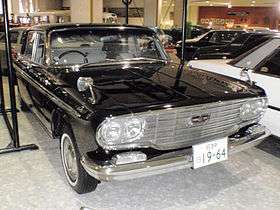 | |
| Overview | |
| Production | Apr 1964–July 1967 |
| Body and chassis | |
| Body style | 4-door sedan |
| Powertrain | |
| Engine | 2.6L (2599cc) V V8 |
| Transmission | 3-speed automatic column |
| Dimensions | |
| Wheelbase | 2,750 mm (108 in) |
| Length | 4,720 mm (186 in) |
| Width | 1,845 mm (72.6 in) |
| Height | 1,460 mm (57 in) |
| Curb weight | 1,375 kg (3,031 lb) |
| Chronology | |
| Successor | Toyota Century |
The longer, wider and more upmarket Crown Eight (ja:トヨタ・クラウンエイト) was introduced in 1964 for the Japanese market, powered by a 2.6 L V8 engine. However, it had a different model designation, VG10. The car was first introduced at the 1963 Tokyo Motor Show and introduced for sale on April 20, 1964, nine days before Emperor Showa's birthday and the beginning of Golden Week in Japan.
The Crown Eight was designed primarily to replace full-sized American automobiles that were commonly used by major corporations. The Crown Eight represents the first Japanese mass-produced vehicle with an 8-cylinder engine. The main rivals at the time were the Prince Gloria Super, Mitsubishi Debonair, and Nissan Cedric Special, all equipped with a six-cylinder engine. It was the first Crown to exceed vehicle size classification regulations in length, width and engine displacement capacity. The width at 1,845 mm (72.6 in) compares to the Century at 1,890 mm (74 in), and as such no Crown before or since, including the Crown Majesta, has matched the width dimension of the Crown Eight until the year 2008 for Crown and 2009 for Majesta.
The Crown Eight was considered as a possible submission for use by the Japanese Imperial Household Agency as a car to be used by senior members of the Imperial House of Japan, but it lost out to the Nissan Prince Royal. The Crown Eight was replaced in 1967 by the first Century with the model code VG20. Approx 3,800 Crown Eights were produced. Some of the items that were exclusive to the Crown Eight were climate control, automatic headlamps, electrically powered windows, electric cruise control, a three-speed "Toyoglide" automatic transmission, and electromagnetic door latches, which were also installed on the Crown Eight successor, the Century.[20]
Third (S50 Model: 1967 to 1971)
| Third Generation | |
|---|---|
 Toyota Crown S50 Super Deluxe Sedan | |
| Overview | |
| Production | 1967–1971 |
| Assembly | |
| Body and chassis | |
| Body style |
|
| Powertrain | |
| Engine | |
| Transmission |
|
| Dimensions | |
| Wheelbase | 2,690 mm (105.9 in)[22] |
| Length |
|
| Width | 1,690 mm (66.5 in) |
| Height |
|
| Curb weight | 1,305 kg (2,877 lb) sedan |
Launched in 1967, the mechanicals were much the same as the previous generation, but additional equipment was included. Higher specification models used the 2.0-liter M engine or the 2.3-liter 2M engine. A premium level Super Saloon joined the Super Deluxe model, and was available with the 2M engine including twin carburettors, electric windows, rear seat radio controls, air conditioning and luxury fabric on the seating including the crown logo embossed into the vinyl. Lower specified models were equipped with the R-series four-cylinder engines. The previous approach of manufacturing Crown vehicles for commercial use, called the Masterline, was discontinued with this generation. Masterline pickups were produced by the former Central Motor Co., Ltd. until December 1970.[10] When the 1967 S50 series Crown was introduced to Japan, television commercials used Japanese actor Satoshi Yamamura, who among his many roles on stage, movie, and television, portrayed Fleet Admiral Isoroku Yamamoto in the 1970s movie Tora! Tora! Tora! Yamamura would serve as the Crown spokesman for 16 years, introducing subsequent new generations of Crown products until 1983.
.jpg)
The Crown range now included the 4-door station wagon, pick-up (rare), double cab pick-up (very rare) and the new two-door hardtop "personal luxury car". In 1969 the Crown received a facelift for the headlight, grill and trim arrangement. The Crown S used the two-litre 'six', but due to sportier tuning it produced more power than the larger 2M, 125 PS (92 kW) at 5,800 rpm versus 115 PS (85 kW) at 5,200 rpm.[22] The commercial versions were fitted with the six-cylinder "M" engine (M-C) produce 105 PS (77 kW), while the four-cylinder 5R had to make do with 93 PS (68 kW).[23] This generation was the only one to use a double-hinged tailgate, as the next generation converted to an overhead-lifting hatchback door.
Crown's that were equipped with the 2,253 cc 2M engine were no longer classified as compact cars under Japanese vehicle size classification regulations, even though the length and width were still in compliance. Toyota offered the larger engine so that buyers who were traditionally served by the Crown could now choose the all-new Corona Mark II in 1968. This allowed Toyota to reposition the Crown as the top level privately available luxury sedan, with much nicer interior treatments, more spacious accommodations. This was the last generation for the pick-up versions of the Crown, as load carrying was ceded to the new Toyota Hilux in February 1971.
Australian market models were assembled in Australia by Australian Motor Industries.[21] This generation was imported fully assembled into New Zealand from 1968 to 1971. Notable features on the wagon were:
- 7 or 8-passenger seating (2 on front buckets or 3 on a bench seat, 3 on a rear bench seat and 2 on a fold up cargo seat),
- a powered rear window,
- a side swing tailgate.
|
Fourth (S60 & S70 Models: 1971 to 1974)
| Fourth Generation | |
|---|---|
_SE_sedan_(2015-12-07)_01.jpg) Toyota Crown sedan (MS65; facelift) | |
| Overview | |
| Production | Feb 1971–Sept 1974[24] |
| Body and chassis | |
| Body style |
|
| Powertrain | |
| Engine | |
| Transmission | |
| Dimensions | |
| Wheelbase | 2,690 mm (105.9 in) |
| Length | 4,680 mm (184.3 in) |
| Width | 1,690 mm (66.5 in) |
| Height | 1,420 mm (55.9 in) |
| Curb weight | 1,290–1,360 kg (2,844–2,998 lb) |
Launched in Feb 1971, the 4M 2600 engine was introduced with this generation, as was the luxurious Super Saloon trim level, followed by the Super Deluxe and Deluxe. The top of the line Royal Saloon was first introduced in the face-lifted Crown from 1973, adding luxury features from the Century limousine. The 2.0-liter 5R inline-four engine and the 2.0-liter M six-cylinder engine were also available. As for the previous generation, the M-C engine (in Japanese specifications) has 105 PS (77 kW; 104 bhp), while the 5R's output increased somewhat to 98 PS (72 kW; 97 bhp).[26][27] In some markets the previous 2.3 litre "2M" six remained available, in sedan or "utility wagon" forms. The Utility Wagon was a version halfway between commercial and passenger car, and had chassis codes MS67V until the early 1973 facelift when it was replaced by the MS68V with the 2.6 engine.[28]
The Sedan and Wagon (Custom) are coded RS60/MS60/MS64/MS65 and MS62/MS63, while the Van was coded MS66V with the two liter "six". The Hardtop Coupe is MS70 (2.0-liter), or MS75 (2.6-liter). The Japanese market Crown Custom (Wagon) was classified as a seven-seater.[27] This generation was the first Crown marketed as a Toyota in Japan, as previous models were marketed as Toyopets. Also, in Japan, this model was known as the "blue whale" or "kujira" Crown.
In 1973, Japanese television commercials introduced Japanese actress Sayuri Yoshinaga as a co-spokeswoman, joining Satoshi Yamamura, and together they appeared in commercials until 1983.
While the domestic market Hardtop has rectangular halogen headlights, all export models come with twin round headlights. This model sold very badly in the US, possibly related to the futuristic styling (called "spindle-shaped" in period marketing material[26]) with flush bumpers that was a bit ahead of its time. Only the first two years were imported to the USA, where it was the last Crown to be sold. The Corona Mark II, replaced the Crown in North America.
The trunk could be opened remotely by turning the ignition key to the far left, and a button on the floor caused the radio to engage the signal seeking feature. A separate signal seeking feature was installed for rear seat passengers, installed behind the front seat facing the rear seat compartment. The 60-series Crown underwent a facelift in January 1973.[28]
Australian models were assembled in Australia by AMI. It was available in New Zealand fully imported from 1971 to 1973, with local assembly beginning at Steels Motor Assemblies - who also built the Corona - not long before the mid-life facelift, improving availability. Steels subsequently became Toyota NZ's Christchurch CKD assembly plant.
In Thailand, this model has a nickname is giant barb.
|
Fifth (S80, S90, & S100 Models: 1974-1979)
| Fifth Generation | |
|---|---|
|
S100 Series Toyota Crown Super Saloon | |
| Overview | |
| Production | Oct 1974–Aug 1979[24] |
| Body and chassis | |
| Body style |
|
| Powertrain | |
| Engine | |
| Transmission |
|
| Dimensions | |
| Wheelbase | 2,690 mm (105.9 in) |
| Length |
4,765 mm (187.6 in) (Royal Saloon) 4,690 mm (184.6 in) |
| Width | 1,690 mm (66.5 in) |
| Height | 1,440 mm (56.7 in) |
| Curb weight | 1,470 kg (3,241 lb) |
Launched in 1974 in Japan, export began from 1975. It was offered as four-door sedan, two-door hardtop coupe, four-door hardtop sedan, wagon, and van. Engines are 2.0 and 2.6-liter gasoline. The 2.2-liter diesel was introduced in October 1977.[29] Trim levels are Standard, Deluxe, Super Saloon, and Royal Saloon.
The Royal Saloon came in a longer bodylength, coupled with the 2.6L engine while lower trim levels were in the shorter bodystyle and 2.0 L engines. Export models used the same body whether the two-litre 5R four-cylinder or the 2.6-litre 4M inline-six. In Europe, these models claimed 87 and 112 PS (64 and 82 kW) respectively.[30]
Minor change was given in 1978. This version of the Crown saw the introduction of disc brakes at both the front and rear axles with anti-lock brakes, speed sensitive power steering, and a 4-speed automatic transmission with overdrive. Originally, sedans and wagons had S80-series chassis numbers, while the two- and four-door hardtops received the S90-series chassis numbers. After 1976 and concurrent with the introduction of new stricter emissions regulations, all Japanese market Crowns used S100-series chassis numbers. Export models continued to use the previous codes.[31]
Initially available with the "old style" 4M engine with rounded valve cover, later models switched to the new 4M engine with rectangular valve cover. This generation also saw the introduction of fuel injection on both the 2.6-liter 4M and the 2.0-liter M engines, coupled with Toyota's TTC-C technology, adding a catalytic converter to the exhaust system. The emissions controlling technology badge helped identify which vehicles had reduced emissions tax liability. Select models also were available with four-wheel disc brakes and twin piston calipers on the front brakes. The models installed with the diesel engine was exclusive to Toyota Diesel Store locations.
The Hardtop Sedan model has a front chrome grill and square headlights, but was no longer considered a true hardtop, due to the inclusion of a "B" pillar. The styling differences between the hardtop and sedan four-door models was that the side windows on the hardtop were frameless, and the rear window was sloped more than the formal appearing sedan. This series Crown in the Royal Saloon trim package exceeded length regulations of 4.7 m set forth by Japanese regulations by 65 mm, but Toyota continued to offer a 2.0 L engine in a shorter vehicle for buyers who were looking for better fuel economy over the larger six-cylinder engines, and reduced road tax liability.
New Zealand models were assembled in New Zealand but on an SKD basis - which meant it had more Japanese content (such as glass) than earlier CKD versions. It was the last Crown built in New Zealand and was replaced in 1979 by the Cressida (MK II), which was available with a four-cylinder engine. The oil crises of 1973/4 and 1979/80 had led the government to impose a 60% sales tax on larger engines, and the Crown could no longer be priced to suit its market.
|
Sixth (S110 Model: 1979 to 1983)
| Sixth Generation | |
|---|---|
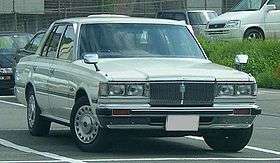 | |
| Overview | |
| Production | 1979–1983 |
| Body and chassis | |
| Body style |
|
| Powertrain | |
| Engine | |
| Transmission |
|
| Dimensions | |
| Wheelbase | 2,690 mm (105.9 in) |
| Length |
4,860 mm (191.3 in) (Royal Saloon) 4,690 mm (184.6 in) |
| Width |
1,715 mm (67.5 in) (Royal Saloon) 1,690 mm (66.5 in) |
| Height | 1,410 mm (55.5 in) |
| Curb weight | 1,500 kg (3,307 lb) |
Launched in 1979, this model had the engine upgraded from the 2.6 L to 2.8 L 5M-EU model. The 2-liter M was still on offer along with a turbocharged version—the M-TEU. The carburated 5M engine was also available in certain markets. In this series the model designation referred to the engine size—MS110 (2-liter), MS111 (2.6-liter), MS112 (2.8-liter). This was the last generation to install a four-cylinder, gasoline-powered engine. This model was the first generation Crown to be sold in Germany, beginning in 1980.[31] The fuel injected 2.8 developed 145 PS (107 kW) in European trim, while the 2.2 diesel offered 66 PS (49 kW) and a choice of five-speed manual or an automatic (not in the Station Wagon).[32] European sales started out at a respectable level, but with prices increasing at an alarming rate due to the appreciation of the yen sales had dropped drastically by 1982.[33]
Early models have twin rectangular headlights, facelift models come with bigger monoblock headlights. Domestic market Royal Saloons use the large rectangular headlights. Lower grades Van and Taxi adopt round headlights. Royal Saloon features longer bumpers and bigger engines, which were placed in a larger road tax classification according to Japanese Government dimension regulations. The first Crown Turbo was launched in October 1980 for Japanese market only. Offering the 2.0 L engines was for buyers who didn't want to pay the large car tax, while offering better fuel economy than the larger engines. The turbo also provided a benefit in increasing fuel efficiency while reducing tailpipe emissions as Japanese consumers pay a tax on the amount of regulated substances being sent into the atmosphere from a Japanese law passed in the 1970s.
This generation is the last for the two-door Hardtop Coupé bodystyle, which was replaced by the Soarer. Reflecting a popular styling appearance during the 1970s, the coupe was fitted with a padded vinyl roof and "opera windows" for a luxurious appearance. Some of the options that became available were an Electronic compass, glass moon roof, power drivers seat, cruise control, electronic stereo tuner, and two-tone paint. Automatic climate control also appeared on this vehicle with separate controls installed for rear seat passengers as well as a rear-mounted mini fridge cooled by the separate rear seat air conditioning unit . The 2.4 L turbo diesel appeared in August 1982.
|
Seventh (S120 Model: 1983 to 1987)
| Seventh Generation | |
|---|---|
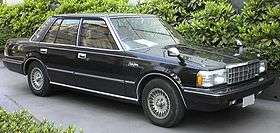 S120 Crown 3.0L Royal Saloon sedan | |
| Overview | |
| Production | 1983–1987 |
| Body and chassis | |
| Body style |
|
| Powertrain | |
| Engine | |
| Dimensions | |
| Wheelbase | 2,720 mm (107.1 in) |
| Length |
4,860 mm (191.3 in) (Royal Saloon) 4,690 mm (184.6 in) |
| Width |
1,720 mm (67.7 in) (Royal Saloon) 1,695 mm (66.7 in) |
| Height | 1,400–1,515 mm (55.1–59.6 in) |
| Curb weight | 1,410–1,875 kg (3,109–4,134 lb) |
Launched in 1983, this model used all three versions of the 5M 2.8L engine, the 5M carburetted version, 5M-E single overhead cam (SOHC) multi-point fuel-injected version, 5M-GE double overhead cam (DOHC), 1G-GE 2.0L DOHC, M-TE 2.0L single overhead cam (SOHC) Turbo, M-E 2.0L SOHC, 2L-TE 2.4L SOHC Turbo Diesel Ceramics Power or 2.0L SOHC Diesel Ceramics Power engines. All 2.0 L engines were installed with T-VIS (Toyota Variable Induction System).
Base versions use the new 2-liter 1G-E engine which replaced the old 2-liter version of the M series. The "van" version of the station wagon (the GS126V as well as the GS136V in the following series) used its own unique variant of this motor (the 1G-EJ).
The lower grade models were available with Toyota's F292 live axle rear suspension while the rest introduced 4-wheel independent suspension branded as PEGASUS (Precision Engineered Geometrically Advanced Suspension) on the Crown for the first time, with TEMS installed on the Royal Saloon sedan and hardtops, coupled with Toyota's ECT electronically controlled four-speed automatic transmission, and 4ESC anti-lock brakes.

The S120 was available in Hardtop sedan (frameless door glass), sedan and wagon versions but in two different exterior dimensions for length and width, with the Royal Saloon hardtop and sedan only offered in the larger body.
The top trim package was called the Royal Saloon, followed by Super Saloon Extra, Super Select for hardtop bodystyles, followed by the Royal Saloon sedan, Super Saloon Extra sedan, and the wagon came only as Super Saloon Extra.
The Super Saloon Extra and Royal Saloon versions were packed with features such as dual-zone climate control, AM/FM cassette stereo with six acoustically matched speakers, combined with a separate rear cassette stereo with headphones, with dashboard-installed integrated CD player, and separate A/C and stereo control buttons installed in the rear armrest, parcel shelf mounted refrigerator, automatic headlights, reading lamps for all outboard seating positions, electrically adjusted tilt and telescoping steering column combined with a steering wheel and seat memory feature, glovebox mounted courtesy mirror among many things, while the slightly lower trim package Super Select was more modestly equipped.
One distinctive styling feature of this generation was the use of a clear panel with patterned backing for the C-pillar trim on the sedans. For the Japanese market only, Toyota made the 190 hp (142 kW) Twincam 12-valve 3.0-liter 6M-GE available on the Royal Saloon for the mid cycle update. This engine is a popular swap for 5M-GE powered Supras and Cressidas of the same period.
Eighth (S130 Model: 1987 to 1991) and Facelift (1991–1997)
| Eighth Generation | |
|---|---|
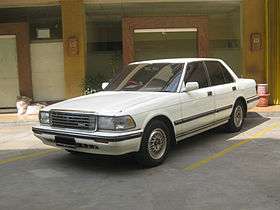 Toyota Crown Sedan 2.0i Super Saloon | |
| Overview | |
| Production | |
| Body and chassis | |
| Body style |
|
| Powertrain | |
| Engine | |
| Transmission |
|
| Dimensions | |
| Wheelbase | 2,730 mm (107.5 in) |
| Length |
4,860 mm (191.3 in) (Royal Saloon) 4,690 mm (184.6 in) (2.0L engine) |
| Width |
1,745 mm (68.7 in) (Royal Saloon) 1,695 mm (66.7 in) (2.0L engine) |
| Height | 1,400 mm (55.1 in) |
| Curb weight | 1,670 kg (3,682 lb) |
Launched in 1987. Body style: Sedan, Hardtop, and Wagon, included the commercial Van. This model used 7M-GE 3000 cc DOHC, 1G-GZE 2000 cc DOHC Super Charger, 1G-E 2000 cc DOHC, 2L-THE 2400 cc SOHC Turbo Diesel Hi Power (AT Use), 2L-TE 2400 cc SOHC Turbo Diesel (MT Use) or 2L 2400 cc SOHC Diesel engines. The 4.0-liter 1UZ-FE, the same engine as in Lexus LS400, was only for Royal Saloon G, which became the Toyota Crown Majesta in the next model revision in 1992. Although a totally different chassis and body, the S130 shares styling cues with the MX83 Cressida. In 1989, the top level Royal Saloon G introduced world's first CD-ROM-based automotive navigation system,[34] with color CRT display.[35] Also, TRC traction control and electronically controlled shock absorbers called TEMS (shared with the first generation Toyota Soarer) were adopted.
In 1991, when the Crown Hardtop was redesigned and became the S140 series, the Crown Sedan and Wagon were also restyled but retained the S130 platform. At this point the 1JZ-GE and 2JZ-GE engines replaced the M-series in-line-six engines for the Crown lineup. In Hong Kong and Singapore, the Crown Sedan with the diesel engine was the most common vehicle used as taxis. The Crown Royal Saloon was an exclusive car. Unique for a large sedan was Crown 3.0 Super Saloon with 5-speed manual transmission sold in Indonesia.
|
Ninth (S140 Models: 1991 to 1995)
| Ninth Generation | |
|---|---|
 | |
| Overview | |
| Production | 1991–1995 |
| Body and chassis | |
| Body style | 4-door hardtop |
| Related | |
| Powertrain | |
| Engine | |
| Transmission |
|
| Dimensions | |
| Wheelbase | 2,730 mm (107.5 in) |
| Length |
4,800 mm (189.0 in) (Royal Saloon) 4,690 mm (184.6 in) |
| Width |
1,750 mm (68.9 in) (Royal Saloon) 1,695 mm (66.7 in) |
| Height | 1,440 mm (56.7 in) |
| Curb weight | 1,620 kg (3,571 lb) |
The Crown Hardtop and all-new Crown Majesta models were built on the 140-series platform. The rebodied Crown Sedan and Wagon still carried S130 model codes, although the exterior is rounder, and the nose is similar to S140 Hardtop. Styling was largely influenced by the newly created Lexus LS, which was later sold in Japan as the Toyota Celsior at Toyopet Store locations, while the Crown and Crown Majesta remained exclusive to Toyota Store locations. This generation Crown platform was also shared with the Toyota Aristo, which was exclusive to Toyota Vista Store locations.
Trim levels for Sedan are Standard, Deluxe, Super Deluxe, Super Saloon, Royal Saloon, and Royal Saloon G. Engine choices were 2.0, 2.5, 3.0-liter gasoline, and 2.4-liter diesel. The 4.0-liter was offered for Royal Saloon G and Majesta.
Although the Crown Majesta was related to the Crown and shared the same S140-series chassis designation, it was bigger, more luxurious and had a V8 engine shared with the Lexus LS and had many expensive electronic options (GPS-based automotive navigation system).[34] The Crown Majesta has been produced as a separate model with distinct styling since 1991.
The Standard Sedan for Taxi and base model Wagon feature round headlights and chrome bumpers. The taxi is powered by 2.4-liter diesel engine matched to 4-speed column-mounted manual transmission.
|
Tenth (S150 Model: 1995-1999)
| Tenth generation | |
|---|---|
 | |
| Overview | |
| Manufacturer | Toyota |
| Production | 1995–1999 |
| Assembly | Toyota City, Nagoya |
| Body and chassis | |
| Body style | |
| Platform | S-series |
| Powertrain | |
| Engine | |
| Transmission |
|
| Dimensions | |
| Wheelbase | 2,780 mm (109.4 in) |
| Length |
4,820 mm (189.8 in) 4,690 mm (184.6 in) (2.0 L) |
| Width |
1,760 mm (69.3 in) 1,695 mm (66.7 in) (2.0 L) |
| Height | 1,425 mm (56.1 in) |
The 150-series Crown were built as Sedan and Hardtop (frameless door window) only. This was the first Crown to not use separate chassis construction. The Wagon retained the old and uninspired 130 series model until 1999. Trim levels for Hardtop are Royal Extra, Royal Saloon, Royal Saloon G, and the sporty Royal Touring. 4WD is offered for Royal Extra and Royal Saloon. Engine is either 2.0, 2.5, or 3.0-liter 6-cylinder. As with previous generations, all vehicles with the 2.0 L engine were offered in a slightly shorter and narrower vehicle so as to be in compliance with Japanese Government dimension regulations.
At its introduction in 1996, it won the Automotive Researchers' and Journalists' Conference Car of the Year award in Japan which it shared with the Crown Majesta.
This generation Crown was not exported in great numbers. It was mainly sent to Southeast Asian markets such as Singapore and Hong Kong. These Crowns, with sedan rather than hardtop bodywork, were fitted either with the 2.0-litre 1G-FE or the 3-litre 2JZ-GE unit depending on market conditions.
|
Crown Comfort (XS10 models: 1995 - current)
In an effort to return to the original purpose of the Crown, which was to serve as a taxi, the Crown Comfort had smaller exterior dimensions but a roomier and taller interior than the Crown Royal series.
To reduce unnecessary cost and weight and increase interior space, the more luxurious dashboard and fitments (including leather seats) of the Crown Royal were replaced with less bulky all-plastic versions. The Comfort is also used as an instructional vehicle for people learning how to drive.
The Comfort is powered by either the 3C diesel engine (5L for the Singapore market, LXS10) or the 2-litre 3Y-PE LPG engine (YXS10). The Japanese model has fender mirrors and an automatic (driver-activated) rear door. The Crown Comfort is popular among taxicab in Japan, Hong Kong and Singapore in the past, but is gradually falling out of favour as better-appointed vehicles become available at competitive cost.
The new Crown Sedan for the Japanese market only is based on the Comfort, but has wider tail lights and longer bumpers.
Eleventh (S170 Model: 1999 to 2003)
| Eleventh generation | |
|---|---|
 | |
| Overview | |
| Manufacturer | Toyota |
| Production |
|
| Assembly | Toyota City, Nagoya |
| Body and chassis | |
| Body style | |
| Powertrain | |
| Engine | |
| Transmission |
|
| Dimensions | |
| Wheelbase | 2,780 mm (109.4 in) |
| Length |
4,820 mm (189.8 in) 4,690 mm (184.6 in) (2.0 L) |
| Width |
1,765 mm (69.5 in) 1,695 mm (66.7 in) (2.0 L) |
| Height | 1,465 mm (57.7 in) |
The 170-series, launched in September 1999, features shorter front overhang therefore maximizes interior and trunk space. There are two different 170-series 4-door Saloon; the Royal, and Athlete. The Majesta is a separate vehicle which is larger and longer than the Crown. The 4-door Hardtop was discontinued. The 170-series Estate launched in December 1999 was the first new Crown Wagon after the 130-series. Engine is either 2.0, 2.5, or 3.0. The Athlete V has 2.5-liter 1JZ-GTE turbo. The Royal was also offered with a 3.0-liter 2JZ-FSE mild hybrid.
An innovation was the electronically controlled (Toyota Electronic Modulated Suspension) air suspension combining nonlinear H-infinity control of damping force and roll-orientation control.[8]
|
Twelfth (S180 Model: 2003 to 2008)
| Twelfth generation | |
|---|---|
 | |
| Overview | |
| Manufacturer | Toyota |
| Production | 2003–2008 |
| Assembly |
|
| Body and chassis | |
| Body style | |
| Platform | S-series |
| Powertrain | |
| Engine | |
| Transmission |
|
| Dimensions | |
| Wheelbase | 2,850 mm (112.2 in) |
| Length | 4,840 mm (190.6 in) |
| Width | 1,780 mm (70.1 in) |
| Height | 1,470 mm (57.9 in) |
The S180 model of the Crown, released in late 2003, was based on the Zero Crown concept car. The engine was changed to a V6 for the new Royal and Athlete models, while the Crown Majesta used the V8 only, now in 4.3-liter form with 4WD optional. The new engines gave more performance while also giving better fuel economy.[37] Radar Pre-Collision System added a single digital camera to improve the accuracy of collision forecast and warning and control levels.[34][38][39]G-BOOK is introduced in May 2006.
Compared with the previous model, this model was increased by 70 mm (2.8 in) in the wheelbase and 15 mm (0.6 in) in body width. These changes gave it the largest interior size among its contemporaries, more than the Mercedes-Benz S-Class or BMW 7-series.[37] The slightly shorter and narrower versions with a 2.0 L engine are no longer offered as a Crown, with the Crown Comfort having assumed the market position in Japan for vehicles that complied with Japanese Government dimension regulations.
The S170 series Crown Estate was continued alongside the S180 sedans. It continued to use the older inline six-cylinder engines.
|
Thirteenth (S200 Model: 2008 to 2012)
| Thirteenth generation | |
|---|---|
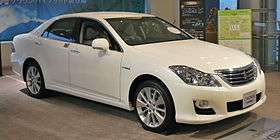 | |
| Overview | |
| Manufacturer | Toyota |
| Production | 2008–2012 |
| Assembly |
|
| Body and chassis | |
| Body style | 4-door sedan |
| Platform | S-series |
| Powertrain | |
| Engine | |
| Transmission |
|
| Dimensions | |
| Wheelbase | 2,850 mm (112.2 in) |
| Length | 4,910 mm (193.3 in) |
| Width | 1,855 mm (73.0 in) |
| Height | 1,470 mm (57.9 in) |
| Curb weight |
|
This generation of the Crown is available in 4 different trim levels: the Crown Royal series which is a more comfortable and luxurious car; the Crown Athlete series which takes the luxurious aspect of the Royal series but has more aggressive styling and sporty features; the Crown Majesta series with different styling and more luxurious features than the Royal series; and the Crown Hybrid series which is a trim level designated for the Hybrid Synergy Drive V6 drivetrain.[42] The larger 4.6 L 1UR-FSE V8 engine incurs a higher road tax liability.
Innovation
- The Crown is one of the first vehicles to have a Navigation/Artificial Intelligence-Adaptive Variable Suspension System (NAVI/AI-AVS) 3 Dimensional Satellite Navigation System coupled with G-BOOK and boasts many features that have not been developed by other luxury car makers. This system can adjust the damper firmness for corners based on map data and change transmission gear shift timings and engine braking for merging on and off highways and approaching tollbooths.
- First Toyota vehicle with active noise control.
- World first Collision avoidance system (PCS) with front-side Millimeter wave radar to detect potential side collisions primarily at intersections or when another vehicle crosses the center line. The latest version tilts the rear seat upward, placing the passenger in a more ideal crash position if it detects a front or rear impact.[43]
- World first PCS Collision avoidance system with GPS-navigation linked brake assist function. The system, which is designed to determine if the driver is late in decelerating at an approaching stop sign, will then sound an alert and can also pre-charge the brakes to provide optimum braking force if deemed necessary. This system works in certain Japanese cities and requires Japan specific road markings that are detected by a CCD camera.
- The Crown Hybrid Night View introduced the first pedestrian detection feature for an active Automotive night vision system. Toyota added a feature which highlights pedestrians and presents them in a box on an LCD display in front of the driver.[44]
- Updated Driver Monitoring System for detecting whether the driver's eyes are properly open.[45] It monitors the driver's eyes to detect the driver's level of wakefulness. This system is designed to work even if the driver is wearing sunglasses, and at night.
- World first center airbag introduced in 2009.
The Crown is set to rival the European BMW 5 series, Mercedes E-class, Audi A6, Jaguar XF, the American Cadillac CTS, and the Japanese Acura RLX, Honda Legend, Infiniti M, and Nissan Fuga. This is the longest and widest Crown to be built until the arrival of the fourteenth generation (S210 model).
The Crown Athlete has been tested to do 0–100 km/h in under 6 seconds, while the Crown Hybrid has been estimated to take 5.4 seconds due to the additional power of the hybrid motor. The mechanically similar Lexus GS 450H Hybrid (GWS191) outputs 253 kW (339 bhp).
The Crown hybrid concept was exhibited at 2007 Tokyo Motor Show. In television commercials in Japan a song was written by composer John Harle titled "How should I my true love know?"
|
Fourteenth (S210 Model: 2012 to present)
| Fourteenth generation | |
|---|---|
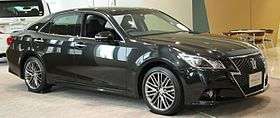 | |
| Overview | |
| Manufacturer | Toyota |
| Production | 2012–present |
| Assembly |
|
| Body and chassis | |
| Body style | 4-door sedan |
| Layout | FR |
| Platform | S-series |
| Related |
Lexus GS Toyota Crown Majesta |
| Powertrain | |
| Engine | |
| Transmission |
|
| Dimensions | |
| Wheelbase | 2,860 mm (112.6 in) |
| Length | 4,885 mm (192 in) |
| Width | 1,800 mm (71 in) |
| Height | 1,495 mm (59 in) |
| Curb weight | 1,825–1,995 kg (4,023–4,398 lb) |
The fourteenth generation Crown was launched in December 2012 with new styling, with the Royal series front styling theme paying homage to the 5th generation MS105 series. Most aspects of the car can be controlled by Toyota Multi-Operation Touch panel.[47]
|
Trademark Dispute
In November 2015, Wuhan Municipal Sanitation Machinery Co., Ltd. sued Toyota and a Wuhan-based automobile dealer for trademark infringement in China based on the similarity of the Toyota Crown logo to Wuhan Municipal Sanitation Machinery’s China Trademark Registration No. 217925. Toyota had requested cancellation of this trademark registration in December 2014, but its request was denied by the China Trademark Office (CTMO).[48]
References
- ↑ Toyota Australia - Timeline Retrieved on 28 March 2012
- 1 2 Toyota USA Automobile Museum. "Timeline". Retrieved 2013-06-11.
- ↑ "Toyopet Crown - the car which laid the foundation of today's prosperity". Archived from the original on 2007-04-04.
- ↑ Toyota: A history of the First 50 Years. Toyota Motor Corporation. 1988. pp. 133/135/137. ISBN 0-517-61777-3.
- ↑ History Timeline of the Japanese automobile, p. 69
- ↑ History Timeline of the Japanese automobile, p. 79
- ↑ History Timeline of the Japanese automobile, p. 83
- 1 2 3 4 "TOYOTA MOTOR CORPORATION GLOBAL WEBSITE - 75 Years of TOYOTA - Technical Development - Chassis".
- ↑ Ozeki, Kazuo (2007).
日本のトラック・バス 1917~1975 [Japanese Trucks and Buses 1917-1975:] (in Japanese). Tokyo: Miki Press. p. 58. ISBN 978-4-89522-487-1. - 1 2 "Affiliates (Toyota wholly-owned subsidiaries)-Toyota Motor East Japan, Inc.". Toyota Motor Corporation. 2012. Retrieved 2014-07-21.
- 1 2 3 4 5 6 "Toyota's Entry into the United States". Toyota. Retrieved 2014-01-31.
- ↑ Hsu, Ben (2013). Classic Japanese Performance Cars. 39966 Grand Avenue, North Branch MN 55056: CarTech Inc. p. 157.
- 1 2 3 4 5 "Toyota USA Museum Passenger Car Timeline". 2014-01-31. Retrieved 2014-01-31.
- ↑ "50th ANNIVERSARY OF TOYOTA IN THE USA". Great Cars. Archived from the original on 2008-12-25. Retrieved 2009-03-04.
- 1 2 3 4 5 Lassa, Todd. "1961 Toyopet Crown Custom And 1967 Toyota Corona 1900 Classic Drive". Motor Trend. Retrieved 2014-02-01.
- ↑ "Toyota's Entry into the United States: Passenger car exports suspended". Toyota. Retrieved 2014-02-01.
- ↑ "Overview of Overseas Production Affiliates: Oceania". Toyota Motor Corporation. 2012. Retrieved 2014-07-11.
- ↑ "Toyota Crown S40". Unique Cars and Parts. Retrieved 2013-11-28.
- ↑ "Item 4. Exports of Completely-built Vehicles". 75 years of Toyota: Vehicle Lineage. Toyota. Retrieved 2013-01-22.
- ↑ "World Celebrated Car File: 1964 Toyota Crown Eight" (PDF). Gazoo.com (in Japanese). Toyota.
- 1 2 Murrell, Paul. "1976 Toyota Crown - Royal Flush". Australian Classic Car. Archived from the original on 2013-10-19.
- 1 2 3 4 5 Braunschweig, Robert; et al., eds. (March 11, 1971). "Automobil Revue '71". 66. Berne, Switzerland: Hallwag SA: 509–510.
- ↑ Toyota Commercial Cars (Catalog), Toyota, 1969, p. 2
- 1 2 Toyota Vehicle Identification Manual. Japan: Toyota Motor Corporation - Overseas Parts Department. 1984. Catalog No.97913-84.
- 1 2 3 4 Quattroruote: Tutte le Auto del Mondo 74/75 (in Italian). Milano: Editoriale Domus S.p.A. 1974. p. 846.
- 1 2 4代目 クラウン バン [Fourth generation Crown Van]. トヨタ自動車75年史 [75 years of Toyota history] (in Japanese). Toyota Motor Co.
- 1 2 愛される車づくり。トヨタはあすにいどみます。 [Lovable car manufacture. Toyota dares to defy tomorrow.] (catalog) (in Japanese), Toyota Motor Co., 1972, p. 1
- 1 2 Toyota Vehicle Identification Manual, Toyota Motor Co., 1979, p. 82, 97911-79
- ↑ "自動車ガイドブック [Japanese Motor Vehicles Guide Book]" (in Japanese). 25. Japan: Japan Automobile Manufacturers Association. 1978-10-10: 109. 0053-780025-3400.
- ↑ Visart, Etienne, ed. (1983-06-02). "La cote officielle de voitures des l'occasion" [Official used car prices]. Le Moniteur de l'Automobile (in French). Brussels, Belgium: Editions Auto-Magazine. 33 (770): 65.
- 1 2 Hajek, Alexander. "Toyota Crown S8/S9/S10". Toyotaoldies.de. Retrieved 2013-08-24.
- ↑ Renaux, Jean-Jacques (1983-11-24). "Referendum van de eigenaars: Toyota Crown Diesel" [Owner referendum]. De AutoGids (in Flemish). Brussels, Belgium: Uitgeverij Auto-Magazine. 4 (109): 12.
- ↑ Renaux, p. 13
- 1 2 3 "TOYOTA MOTOR CORPORATION GLOBAL WEBSITE - 75 Years of TOYOTA - Technical Development - Electronics Parts".
- ↑ "Toyota Crown Royal 1987". http://www.favcars.com/. Retrieved 2015-01-19. External link in
|website=(help) - ↑ "International Cooperation". Faw.com. 2002-08-29. Retrieved 2010-07-25.
- 1 2 "Car and Driver HK". Car and Driver HK (Jan). 2004.
- ↑ "Toyota Crown Majesta undergoes complete redesign".
- ↑ http://www.designnews.com/article/27-Safety_Rules_the_Road.php (Really Playing it Safe)
- ↑ "Affiliates (Toyota wholly-owned subsidiaries)-Toyota Motor East Japan, Inc.". Toyota. 2012. Retrieved 2014-07-15.
- ↑ "Motomachi Plant". Toyota Motor Corporation. 2012. Retrieved 2014-02-14.
- ↑ "Motor1.com - Car Reviews, Automotive News and Auto Show Coverage".
- ↑ http://www.toyota.co.jp/en/news/09/0226.html Toyota Adds to Pre-crash Safety Technologies
- ↑ Korzeniewski, Jeremy (2008-05-31). "Toyota introduces Night View on Japanese Crown Hybrid — Autoblog Green". Autobloggreen.com. Retrieved 2009-12-08.
- ↑ http://www.toyota.co.jp/en/news/08/0122.html Toyota Enhances Pre-crash Safety System with Eye Monitor
- ↑ "Japanese Production Sites". Toyota. 2015-03-06. Archived from the original on 2015-03-18.
- ↑ "Toyota Launches New 'Crown' Series Sedans in Japan" (Press release). Japan: Toyota. 2012-12-25. Retrieved 2012-12-30.
- ↑ "Toyota trademark dispute over Crown logo". WebJD China. 2016-01-28. Retrieved 2016-01-28.
- GP企画センター [GP Planning Center], ed. (2006). 日本自動車史年表 [History Timeline of the Japanese automobile]. Tokyo, Japan: GP Publications. ISBN 978-4-87687-286-2.
External links
| Wikimedia Commons has media related to Toyota Crown. |
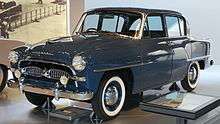


.jpg)



_station_wagon_(21142028621).jpg)


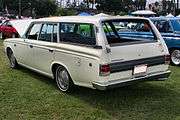

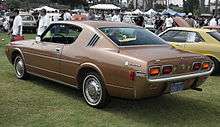
_SE_sedan_(2015-12-07)_03.jpg)


